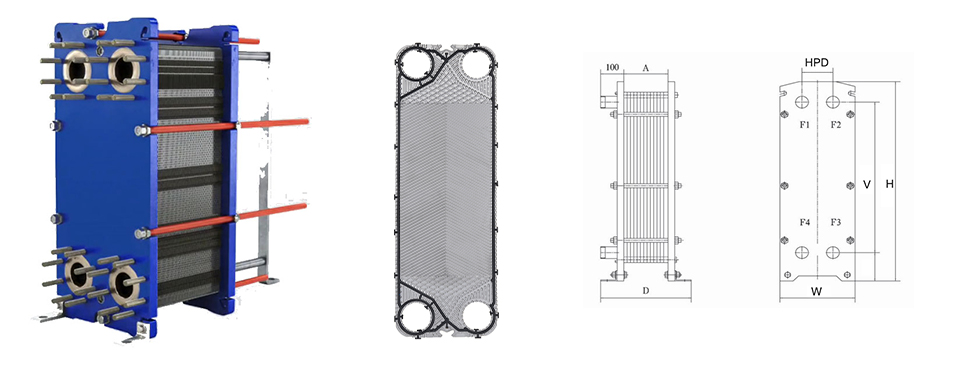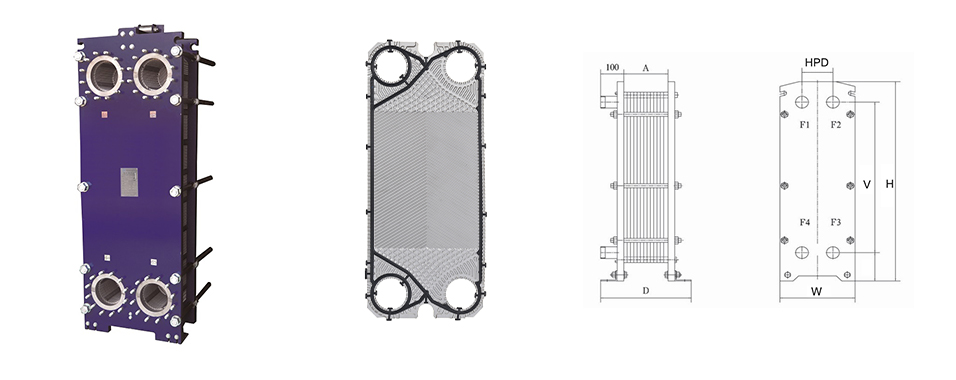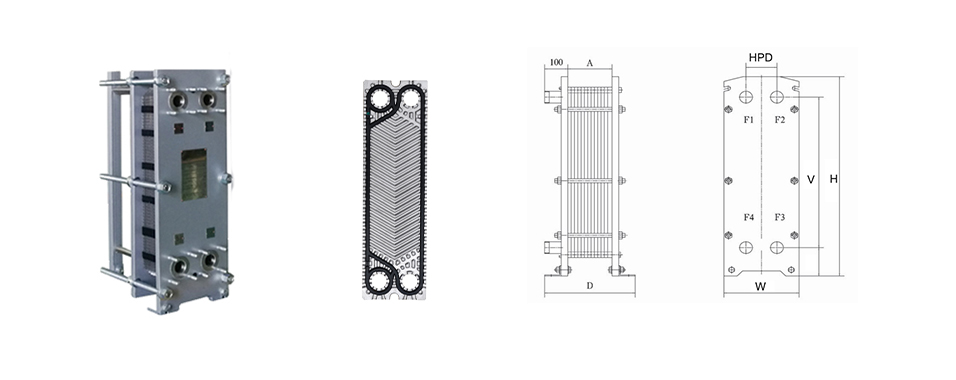Classification of heat exchangers | heat exchanged cooler
1. Floating head heat exchanger: Its advantage is that it can eliminate the stress of temperature difference and can work under high temperature and high pressure. The general temperature is less than or equal to 450 ℃, and the pressure is generally less than or equal to 6.4 MPa; the tube bundle of the heat exchanger can be extracted for cleaning. Used in occasions that are prone to fouling or where the tube length is prone to corrosion. Its disadvantage is that the structure is complex, and the small floating head is prone to internal leakage. Consumption of metal materials is more expensive than ordinary heat exchangers
2. Tubular heat exchanger: Its advantages are low cost, simple and compact structure. The disadvantage is that the tube bundle cannot be cleaned, and there is a large temperature difference stress between the tube wall and the shell wall.
3. U-tube heat exchanger: its advantage is that the tube bundle can be freely expanded and contracted, there is no thermal stress between the tube and shell, the tube pass is double tube pass, the process is long, the heat exchange effect is good, the pressure bearing capacity is strong, the structure is simple, and the cost is low. , The tube bundle can be drawn out from the inside of the shell for easy maintenance. The disadvantage is that the cleaning in the tube remains unchanged, the tube in the middle of the tube bundle is difficult to replace, the distribution of the tube is not compact, the shell side fluid is easy to short-circuit and cause heat exchange inconvenience, and the tube is easy to bend. The heat exchanger is limited to places with large temperature difference in the shell side, or high temperature, high pressure, and strong corrosiveness.
4. Immersion snake heat exchanger: Its advantages are simple structure, easy to install and maintain, easy to corrosion, and high pressure bearing. The disadvantage is that the equipment is bulky and the consumables are large.
5. Spray type snake tube heat exchanger: Its advantages are that the heat exchange efficiency is better than that of the immersed type, the heat transfer area is large, and the maintenance and cleaning are convenient. The disadvantage is that the spray is not uniform, and it is often used to cool the fluid in the pipe. Mostly set in the outdoor air circulation.
6. Double-pipe heat exchanger: Its advantages are large heat transfer area and high heat exchange efficiency. The disadvantage is troublesome maintenance and cleaning, and leakage at the detachable link is easy to cause.
7. Spiral plate heat exchanger: its advantages are good heat transfer efficiency, strong operational feasibility, and low resistance. The disadvantages are high welding quality requirements, strong operational reliability, and low resistance. The disadvantages are high requirements for welding quality, difficult maintenance, heavy weight, poor rigidity, and difficult installation.
8. Heat exchanger with compensation ring: its advantage is that the compensation ring or expansion joint can eliminate thermal stress. When the shell and tube bundle are different, the compensation ring is easy to deform, stretch or compress to adapt to the different expansion structure of the shell and tube bundle. The temperature difference between the two fluids is not more than 70℃, and the shell pressure is not more than 600kpa
9. Heat pipe heat exchanger: Its advantages are high heat transfer efficiency, compact structure, corrosion resistance, and strong environmental adaptability.
10. Jacketed heat exchanger: Its advantages are simple structure and easy transportation, but its disadvantages are small heat transfer area and low heat transfer coefficient.
11. Plate-fin heat exchanger: compact and lightweight structure, high heat transfer coefficient, strong applicability. The disadvantage is that the manufacturing process is complicated, easy to block, not resistant to acid and alkali, and difficult to repair.
In addition, gas cooling towers, regenerators, bathroom warm water heating, and energy storage heat exchangers also belong to heat exchangers.
heat exchanged cooler
2. Tubular heat exchanger: Its advantages are low cost, simple and compact structure. The disadvantage is that the tube bundle cannot be cleaned, and there is a large temperature difference stress between the tube wall and the shell wall.
3. U-tube heat exchanger: its advantage is that the tube bundle can be freely expanded and contracted, there is no thermal stress between the tube and shell, the tube pass is double tube pass, the process is long, the heat exchange effect is good, the pressure bearing capacity is strong, the structure is simple, and the cost is low. , The tube bundle can be drawn out from the inside of the shell for easy maintenance. The disadvantage is that the cleaning in the tube remains unchanged, the tube in the middle of the tube bundle is difficult to replace, the distribution of the tube is not compact, the shell side fluid is easy to short-circuit and cause heat exchange inconvenience, and the tube is easy to bend. The heat exchanger is limited to places with large temperature difference in the shell side, or high temperature, high pressure, and strong corrosiveness.
4. Immersion snake heat exchanger: Its advantages are simple structure, easy to install and maintain, easy to corrosion, and high pressure bearing. The disadvantage is that the equipment is bulky and the consumables are large.
5. Spray type snake tube heat exchanger: Its advantages are that the heat exchange efficiency is better than that of the immersed type, the heat transfer area is large, and the maintenance and cleaning are convenient. The disadvantage is that the spray is not uniform, and it is often used to cool the fluid in the pipe. Mostly set in the outdoor air circulation.
6. Double-pipe heat exchanger: Its advantages are large heat transfer area and high heat exchange efficiency. The disadvantage is troublesome maintenance and cleaning, and leakage at the detachable link is easy to cause.
7. Spiral plate heat exchanger: its advantages are good heat transfer efficiency, strong operational feasibility, and low resistance. The disadvantages are high welding quality requirements, strong operational reliability, and low resistance. The disadvantages are high requirements for welding quality, difficult maintenance, heavy weight, poor rigidity, and difficult installation.
8. Heat exchanger with compensation ring: its advantage is that the compensation ring or expansion joint can eliminate thermal stress. When the shell and tube bundle are different, the compensation ring is easy to deform, stretch or compress to adapt to the different expansion structure of the shell and tube bundle. The temperature difference between the two fluids is not more than 70℃, and the shell pressure is not more than 600kpa
9. Heat pipe heat exchanger: Its advantages are high heat transfer efficiency, compact structure, corrosion resistance, and strong environmental adaptability.
10. Jacketed heat exchanger: Its advantages are simple structure and easy transportation, but its disadvantages are small heat transfer area and low heat transfer coefficient.
11. Plate-fin heat exchanger: compact and lightweight structure, high heat transfer coefficient, strong applicability. The disadvantage is that the manufacturing process is complicated, easy to block, not resistant to acid and alkali, and difficult to repair.
In addition, gas cooling towers, regenerators, bathroom warm water heating, and energy storage heat exchangers also belong to heat exchangers.
heat exchanged cooler








